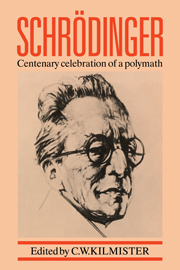Book contents
- Frontmatter
- Contents
- List of contributors
- Preface
- 1 Introduction
- 2 Boltzmann's influence on Schrödinger
- 3 Schrödinger's original interpretation of the Schrödinger equation: a rescue attempt
- 4 Are there quantum jumps?
- 5 Square root of minus one, complex phases and Erwin Schrödinger
- 6 Consequences of the Schrödinger equation for atomic and molecular physics
- 7 Molecular dynamics: from H+H2 to biomolecules
- 8 Orbital presentation of chemical reactions
- 9 Quantum chemistry
- 10 Eamon de Valera, Erwin Schrödinger and the Dublin Institute
- 11 Do bosons condense?
- 12 Schrödinger's nonlinear optics
- 13 Schrödinger's unified field theory seen 40 years later
- 14 The Schrödinger equation of the Universe
- 15 Overview of particle physics
- 16 Gauge fields, topological defects and cosmology
- 17 Quantum theory and astronomy
- 18 Schrödinger's contributions to chemistry and biology
- 19 Erwin Schrödinger's What is Life? and molecular biology
- Index
11 - Do bosons condense?
Published online by Cambridge University Press: 19 January 2010
- Frontmatter
- Contents
- List of contributors
- Preface
- 1 Introduction
- 2 Boltzmann's influence on Schrödinger
- 3 Schrödinger's original interpretation of the Schrödinger equation: a rescue attempt
- 4 Are there quantum jumps?
- 5 Square root of minus one, complex phases and Erwin Schrödinger
- 6 Consequences of the Schrödinger equation for atomic and molecular physics
- 7 Molecular dynamics: from H+H2 to biomolecules
- 8 Orbital presentation of chemical reactions
- 9 Quantum chemistry
- 10 Eamon de Valera, Erwin Schrödinger and the Dublin Institute
- 11 Do bosons condense?
- 12 Schrödinger's nonlinear optics
- 13 Schrödinger's unified field theory seen 40 years later
- 14 The Schrödinger equation of the Universe
- 15 Overview of particle physics
- 16 Gauge fields, topological defects and cosmology
- 17 Quantum theory and astronomy
- 18 Schrödinger's contributions to chemistry and biology
- 19 Erwin Schrödinger's What is Life? and molecular biology
- Index
Summary
Schrödinger's paper (1926) on Bose–Einstein condensation was submitted for publication on 15 December, 1925, immediately preceding the first of his papers on wave mechanics. Historians of science (Hanle, 1977; Klein, 1964) have seen ‘an organic connection’ between the two. It came between the three papers of Einstein (1924, 1925a, b) on the boson gas and Uhlenbeck's doctoral thesis (Uhlenbeck, 1927), and did not receive the attention it deserved, although, with hindsight, it is seen to contain the gem of the idea which was later to resolve the conflict between Einstein and Uhlenbeck. Einstein based his prediction (Einstein, 1925a) of condensation in the free boson gas on a combination of Bose–Einstein statistics and the classical density of states in phase-space; this leads to an expression for the mean particle number density as a function of kinetic energy which saturates as the total density increases so that there is a maximum possible density of particles having nonzero kinetic energy. Einstein claimed that, if the particle density is increased above this maximum, the excess goes into a state with zero kinetic energy. This is the phenomenon of condensation. Uhlenbeck (1927) objected that the result holds only ‘when the quantization of translational motion is neglected’. The situation remained unclear until the Amsterdam meeting to celebrate the centenary (23 November 1937) of the birth of Johannes van der Waals; here Kramers pointed out the importance of the thermodynamic limit for the sharp manifestatioon of phase transitions.
- Type
- Chapter
- Information
- SchrödingerCentenary Celebration of a Polymath, pp. 136 - 145Publisher: Cambridge University PressPrint publication year: 1987

